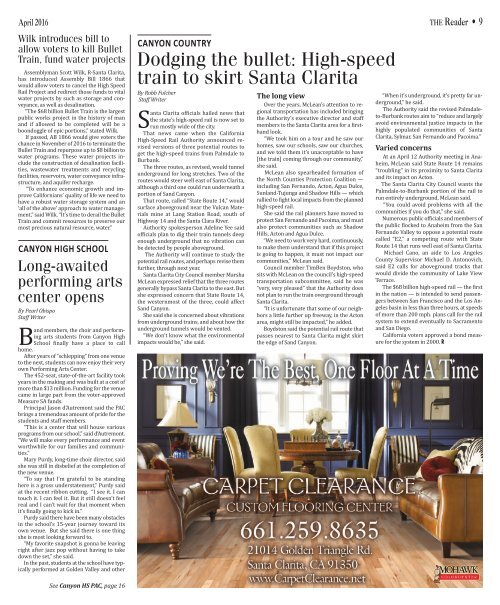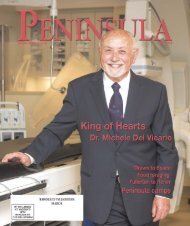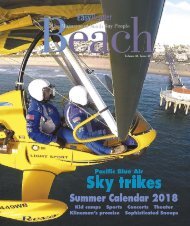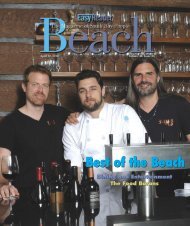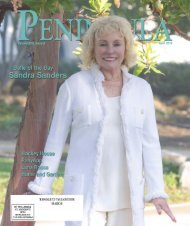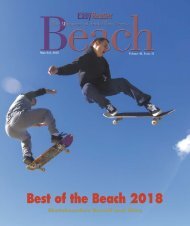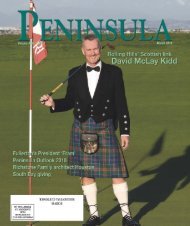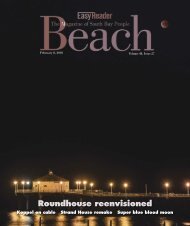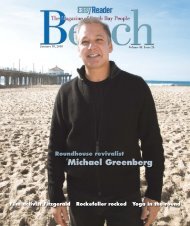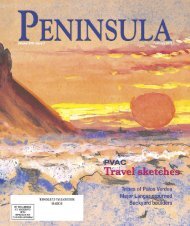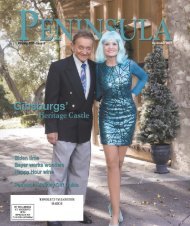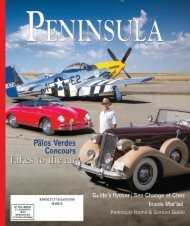Create successful ePaper yourself
Turn your PDF publications into a flip-book with our unique Google optimized e-Paper software.
<strong>April</strong> <strong>2016</strong> THE <strong>Reader</strong> • 9<br />
Wilk introduces bill to<br />
allow voters to kill Bullet<br />
Train, fund water projects<br />
Assemblyman Scott Wilk, R-Santa Clarita,<br />
has introduced Assembly Bill 1866 that<br />
would allow voters to cancel the High Speed<br />
Rail Project and redirect those funds to vital<br />
water projects by such as storage and conveyance,<br />
as well as desalination.<br />
“The $68 billion Bullet Train is the largest<br />
public works project in the history of man<br />
and if allowed to be completed will be a<br />
boondoggle of epic portions,” stated Wilk.<br />
If passed, AB 1866 would give voters the<br />
chance in November of <strong>2016</strong> to terminate the<br />
Bullet Train and repurpose up to $8 billion to<br />
water programs. These water projects include<br />
the construction of desalination facilities,<br />
wastewater treatments and recycling<br />
facilities, reservoirs, water conveyance infrastructure,<br />
and aquifer recharge.<br />
“To enhance economic growth and improve<br />
Californians’ quality of life we need to<br />
have a robust water storage system and an<br />
‘all of the above’ approach to water management,”<br />
said Wilk. “It’s time to derail the Bullet<br />
Train and commit resources to preserve our<br />
most precious natural resource, water.”<br />
canyon high School<br />
Long-awaited<br />
performing arts<br />
center opens<br />
By Pearl obispo<br />
Staff Writer<br />
Band members, the choir and performing<br />
arts students from Canyon High<br />
School finally have a place to call<br />
home.<br />
After years of “schlepping” from one venue<br />
to the next, students can now enjoy their very<br />
own Performing Arts Center.<br />
The 452-seat, state-of-the-art facility took<br />
years in the making and was built at a cost of<br />
more than $13 million. Funding for the venue<br />
came in large part from the voter-approved<br />
Measure SA funds.<br />
Principal Jason d’Autremont said the PAC<br />
brings a tremendous amount of pride for the<br />
students and staff members.<br />
“This is a center that will house various<br />
programs from our school,” said d’Autremont.<br />
“We will make every performance and event<br />
worthwhile for our families and communities.”<br />
Mary Purdy, long-time choir director, said<br />
she was still in disbelief at the completion of<br />
the new venue.<br />
“To say that I’m grateful to be standing<br />
here is a gross understatement,” Purdy said<br />
at the recent ribbon cutting. “I see it. I can<br />
touch it. I can feel it. But it still doesn’t feel<br />
real and I can’t wait for that moment when<br />
it’s finally going to kick in.”<br />
Purdy said there have been many obstacles<br />
in the school’s 15-year journey toward its<br />
own venue. But she said there is one thing<br />
she is most looking forward to.<br />
“My favorite snapshot is gonna be leaving<br />
right after jazz pop without having to take<br />
down the set,” she said.<br />
In the past, students at the school have typically<br />
performed at Golden Valley and other<br />
See Canyon HS PAC, page 16<br />
canyon country<br />
Dodging the bullet: High-speed<br />
train to skirt Santa Clarita<br />
By Robb Fulcher<br />
Staff Writer<br />
Santa Clarita officials hailed news that<br />
the state’s high-speed rail is now set to<br />
run mostly wide of the city.<br />
That news came when the California<br />
High-Speed Rail Authority announced revised<br />
versions of three potential routes to<br />
get the high-speed trains from Palmdale to<br />
Burbank.<br />
The three routes, as revised, would tunnel<br />
underground for long stretches. Two of the<br />
routes would steer well east of Santa Clarita,<br />
although a third one could run underneath a<br />
portion of Sand Canyon.<br />
That route, called “State Route 14,” would<br />
surface aboveground near the Vulcan Materials<br />
mine at Lang Station Road, south of<br />
Highway 14 and the Santa Clara River.<br />
Authority spokesperson Adeline Yee said<br />
officials plan to dig their train tunnels deep<br />
enough underground that no vibration can<br />
be detected by people aboveground.<br />
The Authority will continue to study the<br />
potential rail routes, and perhaps revise them<br />
further, through next year.<br />
Santa Clarita City Council member Marsha<br />
McLean expressed relief that the three routes<br />
generally bypass Santa Clarita to the east. But<br />
she expressed concern that State Route 14,<br />
the westernmost of the three, could affect<br />
Sand Canyon.<br />
She said she is concerned about vibrations<br />
from underground trains, and about how the<br />
underground tunnels would be vented.<br />
“We don’t know what the environmental<br />
impacts would be,” she said.<br />
The long view<br />
Over the years, McLean’s attention to regional<br />
transportation has included bringing<br />
the Authority’s executive director and staff<br />
members to the Santa Clarita area for a firsthand<br />
look.<br />
“We took him on a tour and he saw our<br />
homes, saw our schools, saw our churches,<br />
and we told them it’s unacceptable to have<br />
[the train] coming through our community,”<br />
she said.<br />
McLean also spearheaded formation of<br />
the North Counties Protection Coalition —<br />
including San Fernando, Acton, Agua Dulce,<br />
Sunland-Tujunga and Shadow Hills — which<br />
rallied to fight local impacts from the planned<br />
high-speed rail.<br />
She said the rail planners have moved to<br />
protect San Fernando and Pacoima, and must<br />
also protect communities such as Shadow<br />
Hills, Acton and Agua Dulce.<br />
“We need to work very hard, continuously,<br />
to make them understand that if this project<br />
is going to happen, it must not impact our<br />
communities,” McLean said.<br />
Council member TimBen Boydston, who<br />
sits with McLean on the council’s high-speed<br />
transportation subcommittee, said he was<br />
“very, very pleased” that the Authority does<br />
not plan to run the train overground through<br />
Santa Clarita.<br />
“It is unfortunate that some of our neighbors<br />
a little further up freeway, in the Acton<br />
area, might still be impacted,” he added.<br />
Boydston said the potential rail route that<br />
passes nearest to Santa Clarita might skirt<br />
the edge of Sand Canyon.<br />
“When it’s underground, it’s pretty far underground,”<br />
he said.<br />
The Authority said the revised Palmdaleto-Burbank<br />
routes aim to “reduce and largely<br />
avoid environmental justice impacts in the<br />
highly populated communities of Santa<br />
Clarita, Sylmar, San Fernando and Pacoima.”<br />
Varied concerns<br />
At an <strong>April</strong> 12 Authority meeting in Anaheim,<br />
McLean said State Route 14 remains<br />
“troubling” in its proximity to Santa Clarita<br />
and its impact on Acton.<br />
The Santa Clarita City Council wants the<br />
Palmdale-to-Burbank portion of the rail to<br />
run entirely underground, McLean said.<br />
“You could avoid problems with all the<br />
communities if you do that,” she said.<br />
Numerous public officials and members of<br />
the public flocked to Anaheim from the San<br />
Fernando Valley to oppose a potential route<br />
called “E2,” a competing route with State<br />
Route 14 that runs well east of Santa Clarita.<br />
Michael Cano, an aide to Los Angeles<br />
County Supervisor Michael D. Antonovich,<br />
said E2 calls for aboveground tracks that<br />
would divide the community of Lake View<br />
Terrace.<br />
The $68 billion high-speed rail — the first<br />
in the nation — is intended to send passengers<br />
between San Francisco and the Los Angeles<br />
basin in less than three hours, at speeds<br />
of more than 200 mph. plans call for the rail<br />
system to extend eventually to Sacramento<br />
and San Diego.<br />
California voters approved a bond measure<br />
for the system in 2000. R


